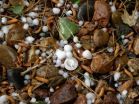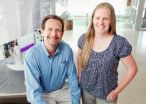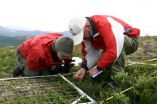(Press-News.org) A biology lab at Washington University has just cracked the structure and function of a protein that plays a key role in the life of a parasite that killed 655,000 people in 2010.
The protein is an enzyme that Plasmodium falciparum, the protozoan that causes the most lethal form of malaria, uses to make cell membrane.
The protozoan cannot survive without this enzyme, but even though the enzyme has many lookalikes in other organisms, people do not make it. Together these characteristics make the enzyme an ideal target for new antimalarial drugs.
The research was published in the January 6 issue of the Journal of Biological Chemistry (JBC) as "Paper of the Week" for that issue.
The work also will be featured in ASBMB Today (the newsletter of the American Society for Biological Molecular Biology, which publishes JBC), and it will be the topic of a JBC podcast.
Sweating the cold room
The protein's structure might have remained an enigma, had it not been the "unreasonable optimism" of Joseph Jez, PhD, associate professor of biology in Arts & Sciences, which carried his team through a six-year-long obstacle course of failures and setbacks.
"What my lab does is crystallize proteins so that we can see what they look like in three dimensions," Jez says. "The idea is that if we know a protein's structure, it will be easier to design chemicals that would target the protein's active site and shut it down," Jez says.
The lastest discovery is the culmination of a project that began years before when Jez was working at the Danforth Plant Science Center in St. Louis and collaborating with scientists at the local biotech startup Divergence.
"At the time, C. elegans had just been sequenced and the Divergence scientists were looking at using it as an easy model to work out the biochemistry of parasitic nematodes," Jez says.
C. elegans is a free-living nematode, or microscopic roundworm, but many nematodes are parasitic and cause disease in plants, livestock and people.
During this project, Lavanya Palavalli, a summer intern working with Jez, crystallized the C. elegans version of the enzyme. The job of the enzyme, phosphoethanolamine methyltransferase, thankfully abbreviated to PMT, is to add methyl groups to a starting molecule, phosophoethanolamine.
"When Soon Goo Lee later took up the project," says Jez, "the plan was to try to grow better crystals of the C. elegans protein, ones good enough to get readable X-ray diffraction patterns.
Two years later, the crystals were looking better but still not good enough.
So Jez suggested that Lee go after homologous (look-alike) proteins in other organisms. "Even though the proteins are homologous, each has a different amino acid sequence and so will behave differently in the crystallizations," Jez says.
"Lee went from working with two C. elegans proteins to three plant proteins, two other nematode proteins and then the Plasmodium protein," Jez says.
"He took all six of those PMT versions into the crystallization trials to maximize his odds," Jez says.
"To crystallize a protein," Jez says, "we put a solution of a salt or something else that might work as a desiccant in the bottom of a small well. And then we put a drop of our liquid protein on a microscope cover slip and flip it over the top of the well, so the drop of protein is hanging upside down in the well."
"What we're trying to do is to slowly withdraw water from the protein. It's exactly like making rock candy, only in that case, the string hanging into the jar of sugar solution helps to withdraw water," he says.
The difference is that sugar wants to form crystals and proteins are reluctant to do so.
"There are 24 wells to a tray, and we usually screen 500 wells per protein at first," Jez says. "Lee had eight proteins and so his first pass was to screen 4,000 conditions. And then he had to try different combinations of ligands to the proteins and crystallize those. This is why it took a few years to finally get where he needed to go."
Road trip!
The scientists need crystals — preferably nice, big ones —to stick in the path of an X-ray beam at Argonne National Laboratory in Chicago. (If the crystal is a good one, and all the atoms are lined up in a repeating array, the scattered X-rays will produce a clear pattern of spots.)
Embedded in that pattern is the mathematical information needed to back-calculate to the position of the atoms in the protein, a process a bit like throwing a handful of pebbles in a lake and then calculating where they landed by the pattern of waves arriving at the
shoreline.
Lee got the PMT from Haemonchus contortus to crystallize first, but there were technical issues with the diffraction pattern that would have made solving it technically and computationally very demanding.
"When the Plasmodium enzyme finally crystallized, Soon got four crystals kind of stacked on top of each other and each of them was paper thin," Jez says.
"I never thought it would work, but we took them to Argonne anyway and he actually did surgery under the microscope and cracked off a little tiny piece of it."
To everyone's surprise, he got a clean diffraction pattern from the crystal. "Because the Plasmodium enzyme was the smallest one and the easiest to work on, we pushed that one first," Jez says.
The moment of truth
"Once we had a Plasmodium crystal that was diffracting really well, we could try back-calculating to see whether we could extract the atom positions from the data," Jez says.
After the computer finished its calculations, Lee clicked a mouse button to see the results, which would reveal whether his years of work finally would pay off.
When Lee clicked the mouse, he got an electron density map in exceptionally sharp focus.
"When you see a map like that, it's like suddenly the wind has kicked up and you're sailing free," Jez says, "because there's this moment, like, before you click that button, no one has ever seen how this protein is put together in three dimensions. You're the first person to ever see it.
"The irony of it is we got such good quality diffraction pattern and electron density maps off such an ugly crystal," he says.
Lock and load
"Once you have the electron density map, the task is to build a structure that matches the amino acid sequence of the protein," Jez says.
"The first thing you do is put in the amino acid backbones and connect them together to form a chain. It's like having a long thread, each inch of which is an amino acid, and your job is to take that thread and move it in three dimensions through that electron density map."
The next step is to add the side chains that make one amino acid different from another, Jez says. "The amino acid sequence is known," he says. "Your goal is to match the way you string together the amino acids in the electron density map to that sequence."
"Once you have the overall structure, you can start to figure out how the enzyme works. The PMT enzyme is trying to join two molecules," Jez says. "To do that, it has to lock them in place so that the chemistry can happen, and then it has to let go of them.
"We think the protein has a lid that opens and closes," he says. "The active site stays open until the substrates enter, and then the lid clamps down, and when it clamps down it actually puts the substrates together."
Calling Bill and Melinda Gates
Not only do infections by Plasmodium falciparum cause the most severe form of malaria, about 40 percent of the human population lives in areas where the parasite is endemic. Moreover, drugs that used to be effective against malaria are beginning to fail, in part because widespread drug counterfeiting has led to resistance.
New anti-malarial drugs are desperately needed, and the PMT protein is an ideal target. If PMT is disabled, the protozoan can't make cell membranes and it dies. Moreover, a drug that would kill Plasmodium might have minimal side effects on patients.
Although the process of identifying compounds that would target PMT is in the early stages, a handful of anti-parasitical compounds used to treat diseases are known to block PMT as well.
As for Lee, he has had a hard go of it, but now things are breaking his way. Plasmodium PMT is giving up its secrets, and the plant and nematode PMTs are coming along as well.
When he clicked the mouse button and a clean electron density map came up, he says, it was like seeing "the light at the end of a five-year-long tunnel."
INFORMATION:
Scientists characterize protein essential to survival of malaria parasite
Because the protein is found in the parasite but not in humans, it is ideal target for an anti-malarial drug
2012-01-09
ELSE PRESS RELEASES FROM THIS DATE:
Climate change is altering mountain vegetation at large scale
2012-01-09
Climate change is having a more profound effect on alpine vegetation than at first anticipated, according to a study carried out by an international group of researchers and published in Nature Climate Change. The first ever pan-European study of changing mountain vegetation has found that some alpine meadows could disappear within the next few decades.
Led by researchers from the Austrian Academy of Sciences and the University of Vienna, biologists from 13 different countries in Europe analysed 867 vegetation samples from 60 different summits sited in all major European ...
'Couch potato pill' might stop heat stroke too
2012-01-09
We've all seen the story in the news before. Whether it's the death of a physically fit high school athlete at football training camp in August, or of an elderly woman gardening in the middle of the day in July, heat stroke is a serious, life-threatening condition for which there is no treatment beyond submersion in ice water or the application of ice packs to cool the body to a normal temperature.
But, in a new study published today in the journal Nature Medicine, scientists discovered what they believe is one of the first drugs to combat heat stroke. AICAR – an experimental ...
Colorado mountain hail may disappear in a warmer future
2012-01-09
Summertime hail could all but disappear from the eastern flank of Colorado's Rocky Mountains by 2070, according to a new modeling study by scientists from NOAA and several other institutions.
Less hail damage could be good news for gardeners and farmers, said Kelly Mahoney, Ph.D., lead author of the study and a postdoctoral scientist at NOAA's Earth System Research Laboratory in Boulder, Colo. But a shift from hail to rain can also mean more runoff, which could raise the risk of flash floods, she said.
"In this region of elevated terrain, hail may lessen the risk of ...
New test spots early signs of inherited metabolic disorders
2012-01-09
A team of scientists, led by researchers at the University of California, San Diego School of Medicine and Zacharon Pharmaceuticals, have developed a simple, reliable test for identifying biomarkers for mucopolysaccharidoses (MPS), a group of inherited metabolic disorders that are currently diagnosed in patients only after symptoms have become serious and the damage possibly irreversible.
The findings will be published online January 8 in the journal Nature Chemical Biology.
MPS is caused by the absence or malfunctioning of a lysosomal enzyme required to break down ...
Evolution of complexity recreated using 'molecular time travel'
2012-01-09
Much of what living cells do is carried out by "molecular machines" – physical complexes of specialized proteins working together to carry out some biological function. How the minute steps of evolution produced these constructions has long puzzled scientists, and provided a favorite target for creationists.
In a study published early online on Sunday, January 8, in Nature, a team of scientists from the University of Chicago and the University of Oregon demonstrate how just a few small, high-probability mutations increased the complexity of a molecular machine more than ...
Team finds a better way to gauge the climate costs of land use changes
2012-01-09
CHAMPAIGN, Ill. — Those making land use decisions to reduce the harmful effects of climate change have focused almost exclusively on greenhouse gases – analyzing, for example, how much carbon dioxide is released when a forest is cleared to grow crops. A new study in Nature Climate Change aims to present a more complete picture – to incorporate other characteristics of ecosystems that also influence climate.
"We know that forests store a lot of carbon and clearing a forest releases carbon dioxide into the atmosphere and contributes to climate change," said University of ...
Graphene reveals its magnetic personality
2012-01-09
In a report published in Nature Physics, they used graphene, the world's thinnest and strongest material, and made it magnetic.
Graphene is a sheet of carbon atoms arranged in a chicken wire structure. In its pristine state, it exhibits no signs of the conventional magnetism usually associated with such materials as iron or nickel.
Demonstrating its remarkable properties won Manchester researchers the Nobel Prize in Physics in 2010.
This latest research led by Dr Irina Grigorieva and Professor Sir Andre Geim (one of the Nobel prize recipients) could prove crucial ...
European mountain vegetation shows effects of warmer climate
2012-01-09
The decade from 2000 to 2009 was the warmest since global climate has been measured, and while localized studies have shown evidence of changes in mountain plant communities that reflect this warming trend, no study has yet taken a continental-scale view of the situation – until now.
With the publication of "Continent-wide response of mountain vegetation to climate change," scheduled for Advance Online Publication (AOP) in Nature Climate Change on 8 January, researchers from 13 countries report clear and statistically significant evidence of a continent-wide warming effect ...
EditCopyProof Launches Fresh Website Catering To Niche Copywriting Needs of Evolutionary Entrepreneurs
2012-01-09
Founder of EditCopyProof, Charlon Bobo, today announced the official launch of a new website featuring products and services specifically developed for evolutionary entrepreneurs. As one of only a few businesses worldwide addressing the specific needs of this market, Bobo is the only copywriter.
Affectionately known as the "conscious copywriter," Bobo enjoys the success of a worldwide clientele and a loyal following of evolutionary entrepreneurs; a quickly-emerging market. The term is a relatively new one, coming onto the business scene within the past year.
Evolutionary ...
2 genes affect anxiety, behavior in mice with too much MeCP2
2012-01-09
HOUSTON -- (Jan. 8, 2012) – The anxiety and behavioral issues associated with excess MeCP2 protein result from overexpression of two genes (Crh [corticotropin-releasing hormone] and Oprm 1 [mu-opioid receptor MOR 1]), which may point the way to treating these problems in patients with too much of the protein, said Baylor College of Medicine scientists in a report that appears online in the journal Nature Genetics.
Much of the work was done at the Jan and Dan L. Duncan Neurological Research Institute at Texas Children's Hospital.
MeCP2 is a "Goldilocks" in the protein ...
LAST 30 PRESS RELEASES:
Gut health à la CAR T
Dr. Pengfei Liu receives 2026 O'Donnell Award in Medicine for pioneering advances in genetic diagnostics and rare disease treatment
Dr. Yunsun Nam receives 2026 O'Donnell Award in Biological Sciences for pioneering RNA research transforming gene regulation and cancer therapy
Dr. Bilal Akin wins 2026 O'Donnell Award in Engineering for transformative work in EV energy systems and industrial automation
Dr. Fan Zhang receives 2026 O'Donnell Award in Physical Sciences for groundbreaking discoveries in quantum matter and topological physics
Dr. Yue Hu receives 2026 O'Donnell Award for revolutionizing energy operations with real-time AI and reinforcement learning
Greater risk that the political right falls for conspiracy theories
JMC Publication: Insilico’s AI platforms enable discovery of potent, selective, oral DGKα inhibitor to overcome checkpoint resistance
Targeting collagen signaling boosts drug delivery in pancreatic cancer
Valvular heart disease is common in cancer patients but interventions improve survival
When socially responsible investing backfires
Cuffless blood pressure technologies in wearable devices show promise to transform care
AI-based tool predicts future cardiovascular events in patients with angina
Researchers map how the cerebellum builds its connections with the rest of the brain during early development
Routine scans could detect early prostate radiotherapy changes
Fairness in AI: Study shows central role of human decision-making
Pandemic ‘beneath the surface’ has been quietly wiping out sea urchins around the world
Tea linked to stronger bones in older women, while coffee may pose risks
School feeding programs lead to modest but meaningful results
Researchers develop AI Tool to identify undiagnosed Alzheimer's cases while reducing disparities
Seaweed based carbon catalyst offers metal free solution for removing antibiotics from water
Simple organic additive supercharges UV treatment of “forever chemical” PFOA
£13m NHS bill for ‘mismanagement’ of menstrual bleeds
The Lancet Psychiatry: Slow tapering plus therapy most effective strategy for stopping antidepressants, finds major meta-analysis
Body image issues in adolescence linked to depression in adulthood
Child sexual exploitation and abuse online surges amid rapid tech change; new tool for preventing abuse unveiled for path forward
Dragon-slaying saints performed green-fingered medieval miracles, new study reveals
New research identifies shared genetic factors between addiction and educational attainment
Epilepsy can lead to earlier deaths in people with intellectual disabilities, study shows
Global study suggests the underlying problems of ECT patients are often ignored
[Press-News.org] Scientists characterize protein essential to survival of malaria parasiteBecause the protein is found in the parasite but not in humans, it is ideal target for an anti-malarial drug




